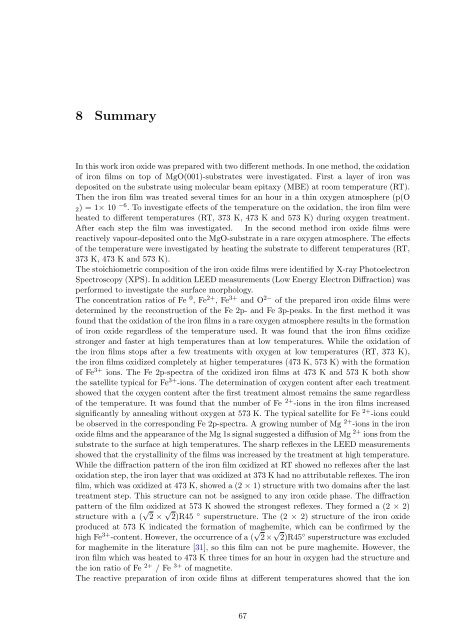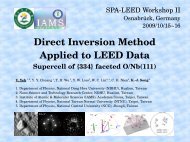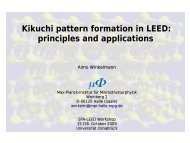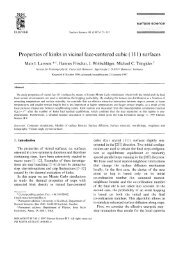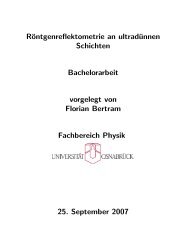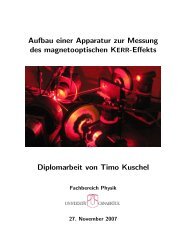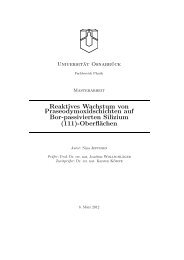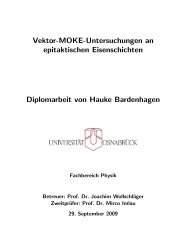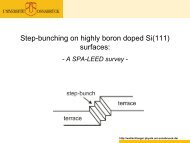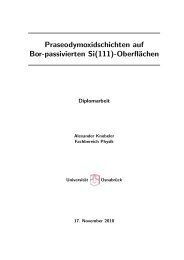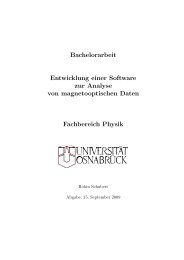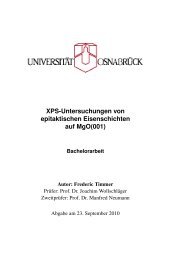Oxidation von Eisenschichten auf MgO(001)-Substraten - Universität ...
Oxidation von Eisenschichten auf MgO(001)-Substraten - Universität ...
Oxidation von Eisenschichten auf MgO(001)-Substraten - Universität ...
Sie wollen auch ein ePaper? Erhöhen Sie die Reichweite Ihrer Titel.
YUMPU macht aus Druck-PDFs automatisch weboptimierte ePaper, die Google liebt.
8 Summary<br />
In this work iron oxide was prepared with two different methods. In one method, the oxidation<br />
of iron films on top of <strong>MgO</strong>(<strong>001</strong>)-substrates were investigated. First a layer of iron was<br />
deposited on the substrate using molecular beam epitaxy (MBE) at room temperature (RT).<br />
Then the iron film was treated several times for an hour in a thin oxygen atmosphere (p(O<br />
2) = 1× 10 −6 . To investigate effects of the temperature on the oxidation, the iron film were<br />
heated to different temperatures (RT, 373 K, 473 K and 573 K) during oxygen treatment.<br />
After each step the film was investigated. In the second method iron oxide films were<br />
reactively vapour-deposited onto the <strong>MgO</strong>-substrate in a rare oxygen atmosphere. The effects<br />
of the temperature were investigated by heating the substrate to different temperatures (RT,<br />
373 K, 473 K and 573 K).<br />
The stoichiometric composition of the iron oxide films were identified by X-ray Photoelectron<br />
Spectroscopy (XPS). In addition LEED measurements (Low Energy Electron Diffraction) was<br />
performed to investigate the surface morphology.<br />
The concentration ratios of Fe 0 , Fe 2+ , Fe 3+ and O 2− of the prepared iron oxide films were<br />
determined by the reconstruction of the Fe 2p- and Fe 3p-peaks. In the first method it was<br />
found that the oxidation of the iron films in a rare oxygen atmosphere results in the formation<br />
of iron oxide regardless of the temperature used. It was found that the iron films oxidize<br />
stronger and faster at high temperatures than at low temperatures. While the oxidation of<br />
the iron films stops after a few treatments with oxygen at low temperatures (RT, 373 K),<br />
the iron films oxidized completely at higher temperatures (473 K, 573 K) with the formation<br />
of Fe 3+ ions. The Fe 2p-spectra of the oxidized iron films at 473 K and 573 K both show<br />
the satellite typical for Fe 3+ -ions. The determination of oxygen content after each treatment<br />
showed that the oxygen content after the first treatment almost remains the same regardless<br />
of the temperature. It was found that the number of Fe 2+ -ions in the iron films increased<br />
significantly by annealing without oxygen at 573 K. The typical satellite for Fe 2+ -ions could<br />
be observed in the corresponding Fe 2p-spectra. A growing number of Mg 2+ -ions in the iron<br />
oxide films and the appearance of the Mg 1s signal suggested a diffusion of Mg 2+ ions from the<br />
substrate to the surface at high temperatures. The sharp reflexes in the LEED measurements<br />
showed that the crystallinity of the films was increased by the treatment at high temperature.<br />
While the diffraction pattern of the iron film oxidized at RT showed no reflexes after the last<br />
oxidation step, the iron layer that was oxidized at 373 K had no attributable reflexes. The iron<br />
film, which was oxidized at 473 K, showed a (2 × 1) structure with two domains after the last<br />
treatment step. This structure can not be assigned to any iron oxide phase. The diffraction<br />
pattern of the film oxidized at 573 K showed the strongest reflexes. They formed a (2 × 2)<br />
structure with a ( √ 2 × √ 2)R45 ◦ superstructure. The (2 × 2) structure of the iron oxide<br />
produced at 573 K indicated the formation of maghemite, which can be confirmed by the<br />
high Fe 3+ -content. However, the occurrence of a ( √ 2× √ 2)R45 ◦ superstructure was excluded<br />
for maghemite in the literature [31], so this film can not be pure maghemite. However, the<br />
iron film which was heated to 473 K three times for an hour in oxygen had the structure and<br />
the ion ratio of Fe 2+ / Fe 3+ of magnetite.<br />
The reactive preparation of iron oxide films at different temperatures showed that the ion<br />
67


